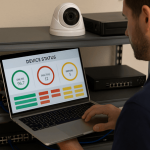
Healthcare facilities rely on a complex workforce that includes not only full-time medical and administrative staff but also contractors, temp workers, traveling nurses, IT vendors, and third-party specialists. These temporary roles are essential—but if not managed properly, they introduce serious security and compliance risks.
Granting access to temporary personnel is a balancing act between operational efficiency and the need to protect patients, staff, and sensitive areas. Here's how hospitals can manage that access responsibly using modern hospital security systems and healthcare access control technology.
k
k
Why Contractor and Temp Access Is a Security Concern
Unlike permanent staff, contractors and temp workers often:
-
Work for short durations (days to weeks)
-
Are not always onboarded with standard security procedures
-
May work irregular hours (overnight, weekends)
-
Come from outside organizations, such as construction crews, cleaning companies, or staffing agencies
If not carefully managed, these variables can lead to:
-
Unauthorized access to patient data or restricted areas
-
Theft or damage to hospital equipment
-
Delays in emergency response if the person is unidentified
-
Non-compliance with HIPAA or Joint Commission standards
k
k
Step-by-Step Guide to Managing Temporary Access
1. Implement Role-Based Access Control (RBAC)
Role-based access control lets hospitals assign permissions based on job function. For contractors and temps, this means:
-
Only granting access to specific areas
-
Limiting access to set days/times
-
Automatically revoking access once a project ends
This prevents over-permissioning and ensures security remains tight, even during shift changes.
k
k
2. Use Credential Expiration and Auto-Revocation
Set auto-expiring credentials that deactivate after a certain period. This is crucial for:
-
Maintenance staff working on a one-week HVAC upgrade
-
Traveling nurses on 13-week assignments
-
IT vendors installing new equipment
By tying access to a calendar or contract end date, hospitals avoid the risk of “zombie credentials” that remain active after the worker has left.
k
k
3. Require Digital Visitor Management for Non-Badged Contractors
For short-term workers who don’t receive full credentials, a visitor management system is essential. These platforms:
-
Log check-in/check-out times
-
Capture ID verification and photos
-
Notify department heads when vendors arrive
-
Provide temporary printed badges or mobile passes
This ensures every person in the facility is accounted for—even if they’re not full-time staff.
k
k
4. Integrate Access Control with HR and Scheduling Systems
Link your hospital’s HR software or staffing platform with your access control system. This allows for:
-
Automatic credential creation and deactivation
-
Credential updates based on schedule changes
-
Real-time oversight for compliance audits
For example, if a staffing agency ends a temp contract early, access privileges are updated immediately—reducing manual workload and risk.
k
k
5. Train Department Leads to Approve and Monitor Access
Temporary access shouldn’t be a one-person decision. Involve:
-
IT or Security teams for credentialing
-
Department heads for role validation
-
Compliance officers to review access logs
This collaborative approach ensures no one falls through the cracks—and access is only granted when truly necessary.
k
k
Best Practices for Credentialing Temporary Workers
| Best Practice | Why It Matters |
|---|---|
| Photo ID on all badges | Ensures visual verification in sensitive areas |
| Unique badge design for contractors | Helps staff distinguish temp workers at a glance |
| Access audit trail | Supports investigations and compliance audits |
| End-of-assignment debrief and badge return | Prevents lost credentials and gathers improvement feedback |
Compliance Considerations: HIPAA & Joint Commission
Both HIPAA and the Joint Commission require hospitals to:
-
Protect patient information from unauthorized access
-
Maintain controlled access to sensitive areas like records storage, medication rooms, and NICUs
-
Demonstrate access control policies during audits
Temporary workers must be trained and monitored like any other employee—especially those who interact with Protected Health Information (PHI).
Failing to manage access properly can lead to:
-
Data breaches
-
Regulatory fines
-
Loss of accreditation
k
k
The Role of Technology in Streamlining Access
Today’s hospital security systems offer powerful tools to help manage this complexity:
-
Mobile credentialing allows secure, temporary access via smartphones
-
Cloud-based access control enables real-time updates and remote revocation
-
Analytics dashboards track who’s coming and going, by role or department
-
Integration with surveillance systems adds an extra layer of oversight
With the right platform, healthcare facilities can efficiently manage hundreds of rotating staff without compromising safety or slowing operations.
k
k
Conclusion: Secure Access Without the Hassle
Contractors and temporary staff keep hospitals running, especially during busy seasons, renovations, or staffing shortages. But their access should be carefully designed, monitored, and revoked the moment it’s no longer needed.
By combining role-based permissions, credential expiration, digital visitor management, and integrated hospital security systems, healthcare leaders can safeguard people, protect data, and maintain smooth operations.
Talk to SSP about securing your hospital with flexible, scalable access control solutions for every member of your team—temporary or permanent.


